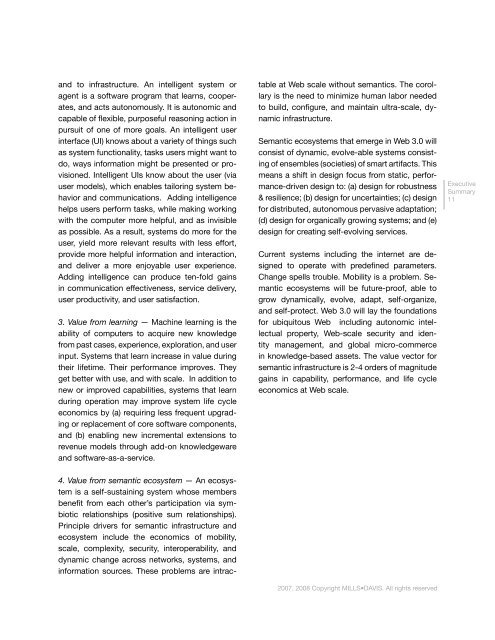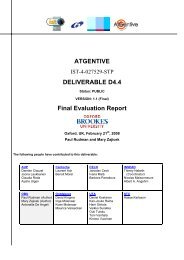Industry Roadmap to Web 3.0 & Multibillion Dollar ... - INSEAD CALT
Industry Roadmap to Web 3.0 & Multibillion Dollar ... - INSEAD CALT
Industry Roadmap to Web 3.0 & Multibillion Dollar ... - INSEAD CALT
You also want an ePaper? Increase the reach of your titles
YUMPU automatically turns print PDFs into web optimized ePapers that Google loves.
and <strong>to</strong> infrastructure. An intelligent system or<br />
agent is a software program that learns, cooperates,<br />
and acts au<strong>to</strong>nomously. It is au<strong>to</strong>nomic and<br />
capable of flexible, purposeful reasoning action in<br />
pursuit of one of more goals. An intelligent user<br />
interface (UI) knows about a variety of things such<br />
as system functionality, tasks users might want <strong>to</strong><br />
do, ways information might be presented or provisioned.<br />
Intelligent UIs know about the user (via<br />
user models), which enables tailoring system behavior<br />
and communications. Adding intelligence<br />
helps users perform tasks, while making working<br />
with the computer more helpful, and as invisible<br />
as possible. As a result, systems do more for the<br />
user, yield more relevant results with less effort,<br />
provide more helpful information and interaction,<br />
and deliver a more enjoyable user experience.<br />
Adding intelligence can produce ten-fold gains<br />
in communication effectiveness, service delivery,<br />
user productivity, and user satisfaction.<br />
3. Value from learning — Machine learning is the<br />
ability of computers <strong>to</strong> acquire new knowledge<br />
from past cases, experience, exploration, and user<br />
input. Systems that learn increase in value during<br />
their lifetime. Their performance improves. They<br />
get better with use, and with scale. In addition <strong>to</strong><br />
new or improved capabilities, systems that learn<br />
during operation may improve system life cycle<br />
economics by (a) requiring less frequent upgrading<br />
or replacement of core software components,<br />
and (b) enabling new incremental extensions <strong>to</strong><br />
revenue models through add-on knowledgeware<br />
and software-as-a-service.<br />
4. Value from semantic ecosystem — An ecosystem<br />
is a self-sustaining system whose members<br />
benefit from each other’s participation via symbiotic<br />
relationships (positive sum relationships).<br />
Principle drivers for semantic infrastructure and<br />
ecosystem include the economics of mobility,<br />
scale, complexity, security, interoperability, and<br />
dynamic change across networks, systems, and<br />
information sources. These problems are intractable<br />
at <strong>Web</strong> scale without semantics. The corollary<br />
is the need <strong>to</strong> minimize human labor needed<br />
<strong>to</strong> build, configure, and maintain ultra-scale, dynamic<br />
infrastructure.<br />
Semantic ecosystems that emerge in <strong>Web</strong> <strong>3.0</strong> will<br />
consist of dynamic, evolve-able systems consisting<br />
of ensembles (societies) of smart artifacts. This<br />
means a shift in design focus from static, performance-driven<br />
design <strong>to</strong>: (a) design for robustness<br />
& resilience; (b) design for uncertainties; (c) design<br />
for distributed, au<strong>to</strong>nomous pervasive adaptation;<br />
(d) design for organically growing systems; and (e)<br />
design for creating self-evolving services.<br />
Current systems including the internet are designed<br />
<strong>to</strong> operate with predefined parameters.<br />
Change spells trouble. Mobility is a problem. Semantic<br />
ecosystems will be future-proof, able <strong>to</strong><br />
grow dynamically, evolve, adapt, self-organize,<br />
and self-protect. <strong>Web</strong> <strong>3.0</strong> will lay the foundations<br />
for ubiqui<strong>to</strong>us <strong>Web</strong> including au<strong>to</strong>nomic intellectual<br />
property, <strong>Web</strong>-scale security and identity<br />
management, and global micro-commerce<br />
in knowledge-based assets. The value vec<strong>to</strong>r for<br />
semantic infrastructure is 2-4 orders of magnitude<br />
gains in capability, performance, and life cycle<br />
economics at <strong>Web</strong> scale.<br />
Executive<br />
Summary<br />
11<br />
2007, 2008 Copyright MILLS•DAVIS. All rights reserved
















